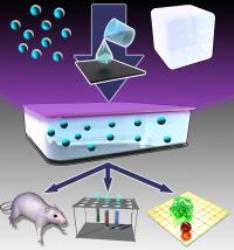A process to produce light in the UV spectrum has been developed by a group of multinational researchers. This process produces glass-based, inorganic LEDs that emit light in the UV spectrum.
 Embedding nanocrystals in glass provides a way to create UV-producing LEDs for biomedical applications
Embedding nanocrystals in glass provides a way to create UV-producing LEDs for biomedical applications
Since, these LED-based lights are cost effective and have chemical stability; they can be used in biomedical and ecological diagnostics. However, acquiring UV emission is quite difficult. This difficulty has been overcome by the new process.
The fabrication process was developed by Sergio Brovelli from Los Alamos National Laboratory in association with a group of scientist, headed by Alberto Paleari, from the University of Milano-Bicocca, Italy.
The study elaborates about an emission of light in the UV range from a novel glass-based substance, which can be attached to the silicon chips. These devices exhibit electroluminescence, electrical conductivity and mechanical stability, and are chemically inert.
The novel idea combines the advanced methods in nanoscience to deliver nanomaterials comprising two or more constituents. The new device has a standard glass, in which, a tin monoxide shell enclosed to tin dioxide nanocrystals has been used. The electrical response of the substance can be controlled by changing the thickness of the shell.
An innovative synthesis strategic plan was developed using a wet chemistry technique that enables LEDs fabrication, where a range of chemical reactions occur in a beaker. Therefore, the glass containing the nanocrystals emits light in the UV spectrum.
This process will be useful for direct implantation into the body as well as to immerse into physiological solutions. Usually, the light is emitted between the interface of semiconductors in conventional diodes, whereas in the oxide-in-oxide model, a substance is produced that enacts like the semiconductor interface present in the glass.
Brovelli stated that the device will be useful for medical diagnosis and can be used either as a light source for implantation into body to activate photochemical reactions or as a lab-on-chip. They can be used for selective activation of photo sensitive drugs or as a probe to detect the existence of fluorescent markers. Hence, for large scale production, these substances can be produced at low cost and can be combined with the existing technology.